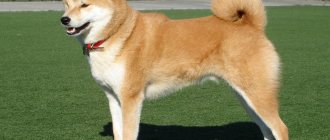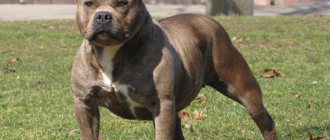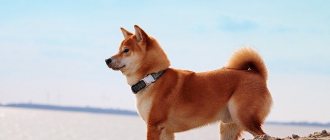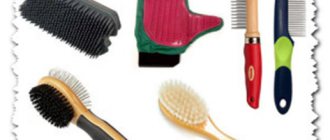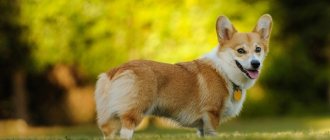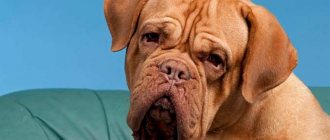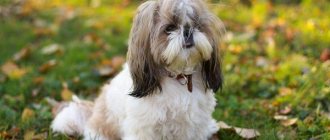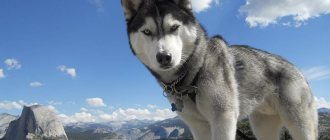This is the smallest representative of the hunting breeds bred in Japan, and today is bred in rural areas as an assistant in hunting and on the farm. The Shiba Inu, or Japanese smiling dog, has become a popular companion dog in recent years.
A small, compact, neat and very intelligent animal is perfect for keeping in an apartment. The Shiba Inu, which is often described in Japanese fairy tales, is very affectionate with all members of the household. She loves to play, but is also quite distrustful of strangers.
The smiling Shiba Inu dog is an excellent friend who will not leave anyone indifferent, thanks to his smiling face and wonderful character.
History of the breed
This breed was formed naturally, with virtually no human intervention. The ancestors of the Shiba Inu dog breed were dogs that were used as peasant helpers in ancient Japan. Small-sized animals were valued for their ability to move in dense thickets at high speed. Hunters used them to hunt wild boars, bears and game.
The development of the Shiba Inu continued for several millennia. Experts believe that its formation began in the 3rd century BC, when the ancestors of these animals were brought by Korean settlers from Asia. In the course of crossing with animals of local breeds, the appearance of the animal known in our time began to emerge. Purebred Japanese Shiba Inu dogs were only selected in the 20th century. The standard was developed and approved in 1934. Two years later (1936), representatives of the breed received the status of a national treasure of the country.
In the 20th century, the Shiba Inu gradually began to spread outside of Japan: in Australia, Europe, and North America. Successful breeding was interrupted by the Second World War. It was during this period that many individuals died, most breed clubs closed, and animal owners, due to a lack of food, were forced to euthanize their pets.
Only after the end of the war did enthusiastic breeders begin to collect surviving specimens to restore the breed. It was decided to combine all the breed lines that existed at that time into one. Of the varieties that existed before the start of the war, three lines remained: San-shiba, Mino-shiba, Shin-shu.
The smiling Shiba Inu dog was restored along with the country's economy. The hunting qualities of representatives of this breed are still valued today. However, in modern Japan and beyond, due to the nature of the Shiba Inu, the animal is more often used as a pet. The US Kennel Club recognized the new breed in 1992. A little later, the National Kennel Club of Canada joined him.
External features
Descriptions of the Shiba Inu today can be found in all cynological publications. In its appearance the animal resembles a fox, and in its habits it resembles a cat. This is a miniature dog with a proportionate, strong build. A lively and strong dog has a proud posture, the silhouette of his body resembles a square in shape. Among other Asian Spitz dogs, the Ulybaka Shiba Inu dog is not much different. She has a strong build, natural proportions, and a dry, toned stomach.
The size of the Shiba Inu is small: height does not exceed 41 cm, with a weight of no more than 14 kilograms. In accordance with the Japanese standard, animals have pronounced sexual dimorphism: the male is distinguished by more powerful bones and developed muscles, and is endowed with a confident and courageous look. Bitches are smaller, have more refined body shapes, a meek and gentle look, and soft movements.
Another requirement of the standard is the strict geometry of the dog’s head and its relationship to the body. Exceeding the size of the head is a non-compliance with the standard. The following deviations are allowed:
- snack or undershot;
- cowardice.
Disqualifying faults include:
- short or uncurled tail;
- floppy ears.
The pointed, fox-like muzzle should not be too narrow. Slightly slanted small eyes look at the world with cunning, but at the same time the gaze is tenacious and firm. All representatives of the breed have one characteristic feature. The smiling dog really almost always smiles and this captivates many animal lovers.
The erect ears are tilted forward, giving the animal a concentrated appearance. A rather thick tail can be straight, but more often it is wrapped in a ring.
Who would like a charming baby?
A cheerful, playful, funny Pomeranian is suitable for those who need “bright rainbows” among gray everyday life. This little miracle can change your mood in an instant and give selfless love and devotion. But you have to pay for everything: the dog cannot stand loneliness, loves long walks and fun activities. He also constantly strives to dominate, to become the “king of the hill.” A patient, persistent, and sometimes demanding owner is able to give the dog the right education and make its life happy.
Coat and color
The adult Shiba Inu has a double coat and a dense, felt-like undercoat. The guard shaft of the hair is hard and elastic. The length of the fur is the same throughout the entire body. Only on the muzzle and paws is it shorter by about 5 centimeters.
The tail is more densely covered due to the raised position of the hair. The coat color can be different: black or red with red or silver tan. With zonal coloring, the ends of the hair are black.
Zonal colors can be:
- black sesame (black predominates over white);
- red sesame (a mixture of black and red flowers);
- sesame (white with black).
Almost white or light sand colors are considered rare and undesirable, according to experts. Such dogs are not allowed to show. The most preferred color is bright red coat. In addition, at exhibitions, preference is given to animals that have white or cream-colored markings (urajiro) on the lower part of the neck, chest, inside the ears, on the cheeks, tail, on the inside of the paws, and on the stomach.
Physical data
The Shiba Inu dog is a very hardy animal. It has an instant reaction, the ability to move through snow and rough terrain with great speed, and maneuverability in motion. Representatives of the breed have an extremely developed instinct of self-preservation, so they become excellent watchdogs, but are not used as a guard.
These cute dogs with a fox face are very sensitive to any suspicious sounds: they inform the owner of the appearance of unwanted guests with a ringing bark. This type of pet is ideal for active, athletic people. The animal happily runs behind a bicycle or accompanies its owner on morning runs.
Types of dog smiles
The theory about the presence of consciousness and emotions in animals first appeared in 2012. Smiling is considered a sign of positive mood or joy. The process is observed before eating, walking or playing. The animal is trying to convey the mood and cheer up the owner.
Sometimes the structure of a dog's muzzle can be mistaken for a smile.
Changing the position of individual parts of the muzzle leads to a smile. Animals can also convey a state of anxiety and nervousness. Dissatisfaction is caused, for example, by heat or cold wind. The position of the lips and mouth is also similar in appearance to a smile.
A grin accompanies aggression. It can also be easily confused with a smile.
Additionally, the dog can growl and bark. A fold of skin is clearly visible on the bridge of the nose. A smile can also indicate a friendly attitude and a desire to spend time with the owner. She puts everyone in a positive mood and energizes everyone around her.
Character
The character of the Shiba Inu is very independent; by nature they are true individualists. In relationships with people, they prefer equal partnership. The dog loves the owner and his family and expects attention from them. If you do not pay attention to your pet for some time, the Shiba Inu begins to get nervous. At the same time, they absolutely cannot tolerate long or annoying caresses. Such a pet will not violently express its feelings. Most often he keeps some distance from the owner.
The animal loves attention to itself, but it does not require close physical contact. The Shiba Inu has an independent character: only she decides what she should do at the moment, where she should go for a walk. If she doesn’t like a command, it is unlikely that a novice in dog breeding, and sometimes even an experienced owner, will be able to force her to carry it out.
The smiling Shiba Inu dog is socially minded: it builds special relationships with each family member. Some of them are playmates, others - during walks. They are happy to make new acquaintances, but only if they do not feel threatened by the new person.
It’s not for nothing that the dog was nicknamed Smiley. And this is connected not only with the expression of her face. This is a very cheerful and playful animal that enjoys communicating with children. Games and mischief are a favorite pastime for such pets. Sometimes furniture and interior items suffer during such entertainment. The dog, as a rule, splashes out excess energy on the street, if the walks are regular and active.
Families with small children should not have such a pet. Excessive activity can be dangerous for babies. If, while eating or playing, the baby encroaches on the animal’s personal space, the dog may bite. But older children, who already understand the rules of communication, get along well with these animals.
Often in the description of the Shiba Inu in various sources it is noted that representatives of this breed do not get along well with other animals. However, experienced dog handlers are confident that, provided proper upbringing, the Shiba Inu gets along with other dogs and even cats.
Effect of oxytocin
According to another study, the results of which were published in the journal Science, oxytocin levels increase in humans and dogs during close interaction. It is a hormone that plays a significant role in creating social bonds. Remarkably, the dogs that experienced the release of oxytocin spent longer looking at people.
“This is the main mechanism of communication and cooperation, since in the case of dogs there is no possibility of verbal contact,” Benjamin says in his interview with Living Science magazine. “Dogs acquired this ability through domestication. They use eye contact as a way to communicate and gather information.”
Features of training and education
If you decide to buy a Shiba Inu puppy, the price of which is quite high, you should know that such a pet needs training from the very first days the baby appears in your home. If you allow a puppy to do whatever he wants at the time of adaptation to a new place, then in the future it will be extremely difficult, and sometimes impossible, to re-educate him. The stubbornness of representatives of this breed can nullify all the efforts of the trainer.
But you can’t put too much pressure on such a pet. Such attempts will only cause protest from the freedom-loving animal. The more harshly you treat this dog, the more stubborn he will become. Understanding and obedience from these animals can be achieved only by building partnerships. It is necessary to make it clear to the animal that its interests are recognized and taken into account.
You should not punish a Shiba Inu (reviews from owners confirm this) if the dog does not immediately follow your command. Sometimes this behavior of a dog is explained by a demonstration of its own importance. However, serious violations of discipline and order in the home cannot be ignored. If your four-legged friend chewed on something or growled at a family member, he should be punished. But this excludes screaming, excessive emotions and physical force. Do not hit the dog under any circumstances: it will only become embittered and completely stop obeying.
The owner must become a true friend of this dog, who can always help and provide support in difficult times. It is important for the owner to convey to his pet that he cannot do without human help. To do this, you should use a variety of situations when the animal feels helpless and insecure:
- Traveling on public transport.
- Visiting a dog park when large dogs are walking around.
In these cases, the owner becomes an assistant and protector of the dog, which will respond to him with obedience in gratitude.
Leash training
The most difficult thing is to accustom a Shiba Inu to a leash, without which it is impossible to walk the dog: a puppy found on the street can rush off in an unknown direction. You need to start with a collar, which is put on the puppy for several days. After this, a leash is attached to it and the puppy is taken outside.
You should go where the dog suggests you. It is necessary to train the puppy to follow its owner gradually, alternating his directions with yours. The character of the Shiba Inu Ulybaka dog is so independent that some individuals cannot be trained to a leash.
Shiba Inu remember commands very quickly, but most often carry them out according to their mood. It is quite difficult to find an animal of this breed that will obey all commands on demand. Most dogs that are, for example, chasing a cat or watching birds are unlikely to respond to the call of their owner calling them to him. However, if these animals are offered a game, the Shiba Inu will enthusiastically fulfill all the requirements.
"Puppy eyes"
This is the name of the dog's facial expression, in which it raises its eyebrows and looks more pitiful than usual.
Scientists conducted a study at a dog shelter. They observed animals as they interacted with people. So, scientists have proven the fact that the more often a dog made “puppy eyes”, the faster people took such pets.
Maintenance and care
The Shiba Inu perfectly maintains the cleanliness of its body on its own. Caring for her is easy. When walking, they diligently avoid puddles and mud, and lick themselves thoroughly when returning home. The fur of these animals practically does not get dirty, and therefore caring for it requires only combing. The dog is rarely bathed, unless absolutely necessary. It is quite difficult to wash a dog well because of the dense undercoat through which water rolls without getting inside. It is necessary to keep your pet in the shower for a long time until the undercoat is completely wet.
Detergents intended for humans dry out the coat, so only use shampoos intended for animals. Shiba Inus are bathed only at night, in the warm season, so that the undercoat can dry before the morning walk. It is not advisable to use a hair dryer for drying.
The Japanese Shiba Inu dog sheds twice a year, and the process is quite intense. At this time, the wool is combed out with a special brush with metal teeth and a slicker brush twice a day. Molting lasts about a month, sometimes a little longer. If you don't comb out the coat, replacing the coat will take longer. You should not comb dry fur: this causes discomfort to the animal and injures the skin. Before combing, you should moisten the coat with oil or a special conditioner.
Once every two weeks, the pet needs to trim its claws, wash its eyes and ears three times a month, and brush its teeth twice a week. Keeping a representative of this breed involves organizing active walks. Such a pet is not suitable for people who spend a lot of time working. Shiba Inus need active physical exercise and new experiences. If this dog is left locked in the house for a long time, it will become aggressive, nervous and unruly.
Nutrition
Poor nutrition can lead to stunted growth and development, since the dog needs nutrients, especially during the period of active growth. The Shiba Inu's diet should include cereals, meat, dairy products, and vegetables. Up to six months, the dog is fed 4-5 times a day. After this, the animal is transferred to two meals a day.
For this breed, natural food is preferable to ready-made dry food. But if you don’t have time, you can also use ready-made formulations. The veterinarian will usually recommend the most preferred brand, although more often owners will choose it by trial. Pay attention to the composition of the feed: it should not contain soy, and the amount of protein should be increased. Avoid food with preservatives, as well as products made using offal. Breeders recommend Grandorf, Monge, and Eukanuba food.
Shiba Inu: owner reviews
Many owners are happy that they purchased a smiling dog. This is a very clean, active, energetic animal that loves active walks. Most owners confirm that the Shiba Inu is an intelligent companion. However, such a pet should not be owned by beginners in dog breeding: it will take a lot of patience and experience to raise it. Many emphasize that self-training for four to five months did not produce any results and they had to turn to professional dog handlers for help.
Girl
Girls weigh 7-10 kilograms, they grow to 35-39 centimeters.
In appearance, females are slightly smaller than males.
The girl is more aloof, especially with strangers. This trait is due to the fact that the female is more cautious.
Neutering also affects her behavior. Spayed females show aggression less intensely.
However, the female Shiba Inu is quite intelligent. Therefore, it is easy to train.
